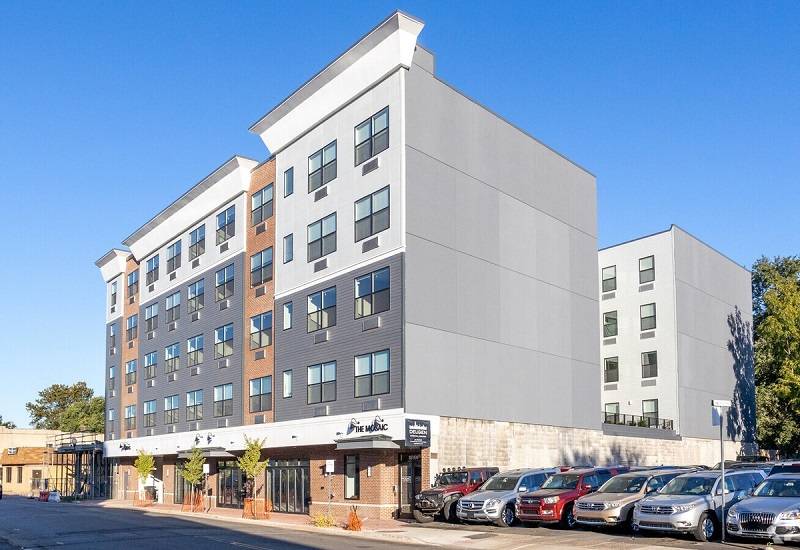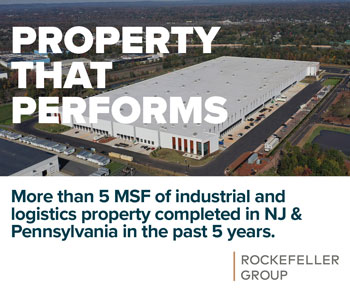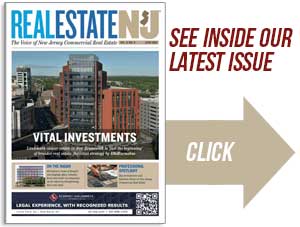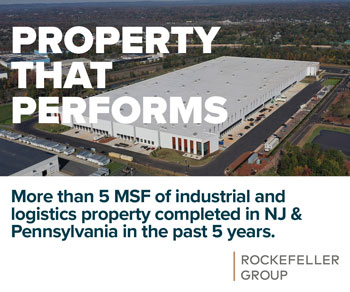Mosaic on Main, a 64-unit apartment building by Reynolds Asset Management, was partially complete when a massive fire destroyed it and other properties in downtown Bound Brook in 2020, causing an estimated $52 million in losses. The developer has since rebuilt it and recently launched leasing at the property, along with a 29-unit sister property called The Vibe. — Courtesy: Striker Apartment Leasing
By Patricia Alex
The focal point in the lobby of Bound Brook’s newest luxury apartment development — a mosaic mural with bursts of vibrant color — is exuberant. Likewise, developers and local officials say they remain bullish that the building and several others in the works will remake the borough’s frayed downtown.

“We’re not only rebuilding but we’re on the upswing. We have a lot of great things happening,” said Councilman Abel Gomez, a member of the council’s economic development committee.
The 64-unit Mosaic on Main was partially complete when a massive fire destroyed it and other properties downtown in 2020, causing an estimated $52 million in losses. Now it has been rebuilt by developer Reynolds Asset Management, along with a 29-unit sister property called The Vibe.
The new units at 7-15 West Main St. are among more than 500 luxury one- and two-bedroom apartments built in Bound Brook during the past seven years, according to Mayor Robert Fazen, after a major flood mitigation project and tax incentives opened the door for aggressive redevelopment of the downtown. At least another 500 upscale units are in various stages of development and efforts are underway to lure quality commercial tenants downtown and create more recreational green space along the Raritan River, officials said.
The efforts center on the conveniently located train station — a stop on NJ Transit’s Raritan Valley line — that sits between the river and West Main Street. The line stops at Newark Penn Station and the commute to Manhattan takes just over an hour. The area has been designated by the state as a Transit Village, which provides it with opportunities to leverage grants for area improvements. The entire downtown also sits within a federal Opportunity Zone, enabling developers to take advantage of tax deferrals and savings for certain longer-term investments.

In all, at least 10 separate projects are pending for the next couple years and preliminary planning has begun for others in the more distant future. Town officials were reluctant to put an exact dollar figure on the redevelopment, but conservatively estimate there has been at least $150 million invested in Bound Brook since the first new development, the 240-unit Meridia Main Station, was built on the east end of Main Street in 2014.
That seminal property opened just before completion of a major federal engineering project to protect the downtown from historical flooding from the Raritan River’s tributaries. Now, with the system of levees, floodgates, floodwalls and pumping stations built by the U.S. Army Corps of Engineers, Fazen said the borough’s flooding problems are largely in the past, although a stalled train blocked the closing of a floodgate during Hurricane Ida last year and caused some minor flooding.
Meridia Main Station is nearly fully leased and the developer, Capodagli Property Co. of Linden, has two other projects pending in the downtown. Leasing also has begun at Mosaic on Main, developed by Reynolds Asset Management in partnership with Bridge Investment Partners and Striker Apartment Leasing. The project, for which Deugen Development served as construction manager, replaced a strip club and its one- and two-bedroom apartments have rents ranging from $1,875 to $2,475. Developers envision commercial tenants like a gastropub in part of the 1,646 square feet of retail space fronting West Main Street.

Brian Jaffe, managing partner at Striker Apartment Leasing, said the train station remains a draw even in an era of remote work hastened by the pandemic. In fact, he said, Bound Brook may have become more attractive as residents who don’t have to commute as often look for alternatives to higher-priced markets in closer to the city and North Jersey.
“Prices are better for all types of properties: apartments, commercial space and housing,” Jaffe said. “It’s a simple fact that renters and owners get more space for their money in small towns like Bound Brook. And Main Street is an up-and-coming district.”
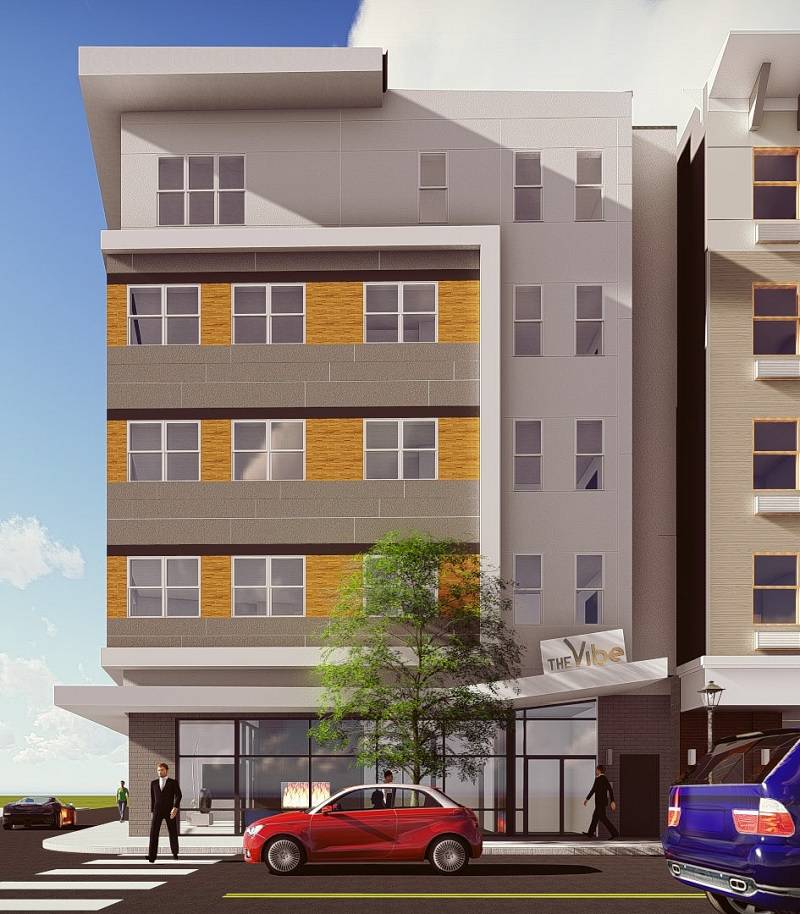
Indeed, commercial development is key to remaking the three-quarter-mile main drag, which is still home to another “gentlemen’s club” and more than a few laundromats, temporary employment agencies and other relatively downscale tenants. Gomez, the councilman, said it’s the “chicken and the egg” situation, predicting that a critical mass of tenants in the luxury buildings will soon spur higher-end commercial development.
The nonprofit Bound Brook Revitalization Partnership administers the Special Improvement District tasked with improving business and cultural development downtown. In 2017, The Brook Theater on Hamilton Street, right off Main, was restored to its 1927-era grandeur — complete with a huge pipe organ — and now operates as a performing arts center that town officials hope will be a lynchpin.
“It’s a one-of-a-kind and we’d like to keep that as a central focus,” Fazen said.
Councilman Jake Hardin, the liaison to the revitalization partnership, said restoration of the theater and other projects allow Bound Brook to preserve its historic flavor while welcoming new development.

“It’s exciting — we’re trying to blend the old and the new together,” Hardin said.
The short street in front of the theater is envisioned as a pedestrian walkway with outdoor dining and other events to draw families and others to the downtown. Another apartment complex called The Hamilton is slated for the thoroughfare on the site of the former Salvation Army. A mixed-use development called The Revo — a nod to the borough’s history as the site of a Revolutionary War battle — is replacing the rundown Bound Brook Hotel, which dated to 1700.
Officials are hoping the downtown can be a regional destination, much in the way neighboring Somerville, two stops west on the Raritan Valley Line, attracts out-of-towners for its many dining options.
“We hope Bound Brook gets recognized for good restaurants and stores,” Fazen said.
The borough still has a way to go, however: The downtown can feel crowded as parking remains a problem, some residents say. And it’s still the poorest town in affluent Somerset County. Officials are banking on the luxury rentals as a way to boost the town’s median income without overburdening the schools, since the smaller units will likely be filled by renters without children. Fazen said he expects Bound Brook’s population, which had held steady at just above 10,000, would increase to about 14,000.
Another Meridia building that was under construction, a 172-unit mixed project, also was destroyed by the fire and is projected to be rebuilt within the next two years. The fire, which was ruled an arson, was a setback, for sure, said Gomez, but also shone a spotlight on the changing character of the downtown.
“All tragedy and chaos brings some kind of opportunity, and the fire brought attention to the luxury development on Main Street,” Gomez said. There have been relatively few complaints about gentrification, the councilman said, and the new developments are a needed shot in the arm for this historic town that was first settled in 1681.
In addition to its mass transit to Manhattan, Bound Brook’s location — near major highways like Interstate 287 and Route 22 and the Bridgewater Commons and Rutgers University — make it ripe for redevelopment, Gomez said.
“We’re an ideal location, next to every single amenity.”
Patricia Alex is a freelance writer based in Cherry Hill and the founder of Silk City Communications.

